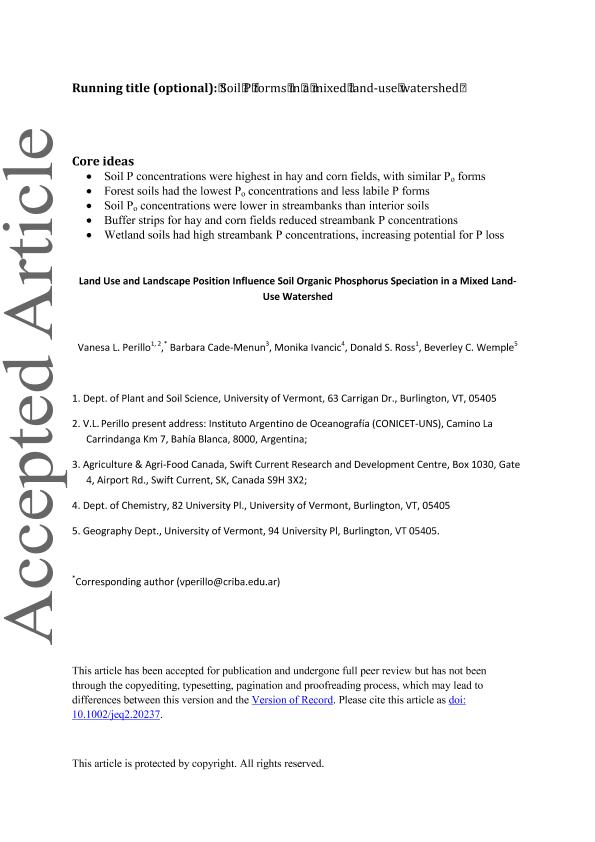Artículo
Land use and landscape position influence soil organic phosphorus speciation in a mixed land‐use watershed
Perillo, Vanesa Liliana ; Cade Menun, Barbara; Ivancic, Monika; Ross, Donald S.; Wemple, Beverley C.
; Cade Menun, Barbara; Ivancic, Monika; Ross, Donald S.; Wemple, Beverley C.
 ; Cade Menun, Barbara; Ivancic, Monika; Ross, Donald S.; Wemple, Beverley C.
; Cade Menun, Barbara; Ivancic, Monika; Ross, Donald S.; Wemple, Beverley C.
Fecha de publicación:
05/2021
Editorial:
American Society of Agronomy
Revista:
Journal of Environmental Quality
ISSN:
0047-2425
Idioma:
Inglés
Tipo de recurso:
Artículo publicado
Clasificación temática:
Resumen
Land use can significantly alter soil P forms, which will influence P loss in runoff. Organic P (Po) compounds are an important component of soil P, but their forms and cycling in soils with different land uses are still poorly understood. In addition, streambanks are potential sources of P loss; P forms and concentrations in streambank soils may vary with land use, affecting potential P loss to water. This study used solution 31P nuclear magnetic resonance spectroscopy (P-NMR) to characterize and quantify P in interior and streambank soils (0-10 cm) under duplicate sites from four different land uses along streams in the Missisquoi River Basin (VT, USA) ? silage corn, hay meadow, emergent wetlands and forest. Orthophosphate monoesters were the dominant P compound class regardless of land use or landscape position. Forest soils had the lowest Po concentrations, less labile P forms than other soils, and significantly lower concentrations of total inositol hexakisphosphates and total orthophosphate monoesters compared to corn soils. Riparian buffer zones for agricultural soils lower P concentrations in streambank soils for many soil P pools relative to interior soils. The wetland soils of this study had P concentrations and P forms that were similar to those for interior agricultural soils, and generally showed no reduction in P concentrations in streambank soils relative to interior soils. This is consistent with the role of wetlands as P sinks in the landscape, but also suggests these wetlands should be carefully monitored to minimize P accumulation, especially in streambank soils.
Palabras clave:
ORGANIC PHOSPHORUS
,
LAND USE
,
RIPARIAN SOIL
,
STREAMBANK SOIL
Archivos asociados
Licencia
Identificadores
Colecciones
Articulos(IADO)
Articulos de INST.ARG.DE OCEANOGRAFIA (I)
Articulos de INST.ARG.DE OCEANOGRAFIA (I)
Citación
Perillo, Vanesa Liliana; Cade Menun, Barbara; Ivancic, Monika; Ross, Donald S.; Wemple, Beverley C.; Land use and landscape position influence soil organic phosphorus speciation in a mixed land‐use watershed; American Society of Agronomy; Journal of Environmental Quality; 50; 5-2021; 967-978
Compartir
Altmétricas



